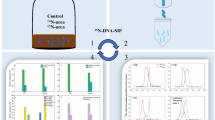Abstract
Autoradiography was used to examine critical questions for trophic studies concerning the uptake of radioactive tracers by a natural assemblage of sedimentary microorganisms. Labeled organic substrates ([3H]-acetate and [3H]-thymidine) were taken up only by heterotrophic bacteria, and [14C]-bicarbonate was taken up only by microalgae. Only approximately 2% of the bacterial assemblage took up detectable quantities of either [3H]-acetate or [3H]-thymidine, regardless of whether labeled substrates were delivered to sediments via slurries or by injection with a microliter syringe. Significantly more diatoms were labeled when [14C]-bicarbonate was delivered to sediments by the injection method (75%) as compared to the slurry method (50%). These results indicate that radio-active tracers can be used in natural sediments to selectively label potential microbial food of invertebrate grazers. Only a small proportion of bacteria, however, may actually use a labeled substrate, which introduces a large uncertainty into the conversion of radioactivity in grazers to the number of bacteria consumed. Finally, the use of disruptive methods (e.g., slurries) to deliver labels to sediments does not increase the proportion of microorganisms that become labeled. Thus, given the variety of artifacts that may be associated with the use of sediment slurries, it is probably advisable to use nondisruptive methods to deliver substrates to sediments.
Similar content being viewed by others
References
Balkwill DL, Labeda DP, Casida LE (1975) Simplified procedures for releasing and concentrating microorganisms from soil for transmission electron microscopy viewing as thin-sectioned and frozen-etched preparations. Can J Microb 21:251–262
Bell SS, Coull BC (1978) Field evidence that shrimp predation regulates meiofauna. Oecologia 35:141–148
Bern L (1985) Autoradiographic studies of [methyl-3H]thymidine incorporation in a cyanobacterium (Microcystis wesenbergii)-bacterium association and in selected algae and bacteria. Appl Environ Microbiol 49:232–233
Brock TD (1967) Bacterial growth rate in the sea: Direct analysis by thymidine autoradiography. Science 155:81–83
Brock TD, Brock ML (1966) Autoradiography as a tool in microbial ecology. Nature 209:734–736
Brock TD, Madigan MT (1988) Biology of microorganisms, 5th ed. Prentice Hall, Englewood Cliffs, NJ
Carman KR, Dobbs FC, Guckert JB (1989) Comparison of three techniques for administering radiolabeled substrates to sediments for trophic studies: Uptake of label by harpacticoid copepods. Mar Biol 102:119–125
Carman KR, Thistle D (1985) Microbial food partitioning by three species of benthic copepods. Mar Biol 88:143–148
Conover RJ, Francis V (1973) The use of radioactive isotopes to measure the transfer of materials in aquatic food chains. Mar Biol 18:272–283
Dobbs FC, Guckert JB, Carman KR (1989) Comparison of three techniques for administering radiolabeled substrates to sediments for trophic studies: Incorporation by microbes. Microb Ecol 17:237–250
Douglas DJ, Novitsky JA, Fournier RO (1987) Microautoradiography-based enumeration of bacteria with estimates of thymidine-specific growth and production rates. Mar Ecol Prog Ser 36:91–99
Feller RJ, Zagursky G, Day EA (1985) Deep-sea food web analysis using cross-reacting antisera. Deep-Sea Res 32:485–497
Fleeger JW, Decho AW (1987) Spatial variability of interstitial meiofauna: A review. Stygologia 3:35–54
Gee JM, Warwick RM, Davey JT, George CL (1985) Field experiments on the role of epibenthic predators in determining prey densities in an estuarine mudflat. Estuar Cstl Shelf Sci 21:429–448
Hagstrom A, Larsson U, Horstedt P, Normark S (1979) Frequency of dividing cells, a new approach to the determination of bacterial growth rates in aquatic environments. Appl Environ Microbiol 37:805–812
Hicks GRF, Coull BC (1983) The ecology of marine meiobenthic harpacticoid copepods. Oceanogr Mar Biol Ann Rev 21:67–175
Hobbie JE, Daley RJ, Jasper S (1977) Use of nucleopore filters for counting bacteria by fluorescence microscopy. Appl Environ Microbiol 33:1225–1228
Hoffman JA, Katz J, Bertness MD (1984) Fiddler crab deposit-feeding and meiofaunal abundance in salt marsh habitats. J Exp Mar Biol Ecol 82:161–174
Hollander M, Wolfe DA (1973) Nonparametric statistical methods. John Wiley and Sons, New York
Hollibaugh JT, Fuhrman JA, Azam F (1980) Radioactively labeling of natural assemblages of bacterioplankton for use in trophic studies. Limnol Oceanogr 25:172–181
Juniper SK (1981) Stimulation of bacterial activity by a deposit feeder in two New Zealand intertidal inlets. Bull Mar Sci 3:691–701
McIntyre AD (1969) Ecology of marine meiobenthos. Biol Rev 44:245–290
Meyer-Reil L-A (1978) Autoradiography and epifluorescence microscopy combined for the determination of number and spectrum of actively metabolizing bacteria in natural waters. Appl Environ Microb 36:506–512
Montagna PA (1984) In situ measurement of meiobenthic grazing rates on sediment bacteria and edaphic diatoms. Mar Ecol Prog Ser 18:119–130
Montagna PA, Bauer JE (1988) Partitioning radiolabeled thymidine uptake by bacteria and meiofauna using metabolic blocks and poisons in benthic feeding studies. Mar Biol 98:101–110
Munro ALS, Brock TD (1968) Distinction between bacterial and algal utilization of soluble substances in the sea. J Gen Microbiol 51:35–42
Novitsky JA (1983) Heterotrophic activity throughout a vertical profile of seawater and sediment in Halifax Harbor, Canada. Appl Environ Microbiol 45:1735–1760
Novitsky JA (1987) Microbial growth rates and biomass production in a marine sediment: Evidence for a very active but mostly nongrowing community. Appl Environ Microbiol 53:2368–2372
Rivkin RB (1986) Incorporation of tritiated thymidine by eucaryotic microalgae. J Phycol 22:193–198
Rogers AW (1977) Techniques of autoradiography. Elsevier/North-Holland Biomedical, NewYork
Round FE (1971) Benthic marine diatoms. Oceanogr Mar Biol Ann Rev 9:81–139
Round FE (1979) A diatom assemblage living below the surface of intertidal sand flats. Mar Biol 54:219–223
Sogard SM (1984) Utilization of meiofauna as a food source by a grassbed fish, the spotted dragonetCallionymus pauciradiatus. Mar Ecol Prog Ser 17:183–191
Stanley PM, Staley JT (1977) Acetate uptake by aquatic bacterial communities measured by autoradiography and filterable radioactivity. Limnol Oceanogr 22:26–37
Tabor PS, Neihof RA (1982) Improved microautoradiographic method to determine individual microorganisms active in substrate uptake in natural waters. Appl Environ Microbiol 44:945–953
Tabor PS, Neihof RA (1984) Direct determination of activities for microorganisms of Chesapeake Bay populations. Appl Environ Microbiol 48:1012–1019
Author information
Authors and Affiliations
Rights and permissions
About this article
Cite this article
Carman, K.R. Radioactive labeling of a natural assemblage of marine sedimentary bacteria and microalgae for trophic studies: An autoradiographic study. Microb Ecol 19, 279–290 (1990). https://doi.org/10.1007/BF02017172
Issue Date:
DOI: https://doi.org/10.1007/BF02017172




